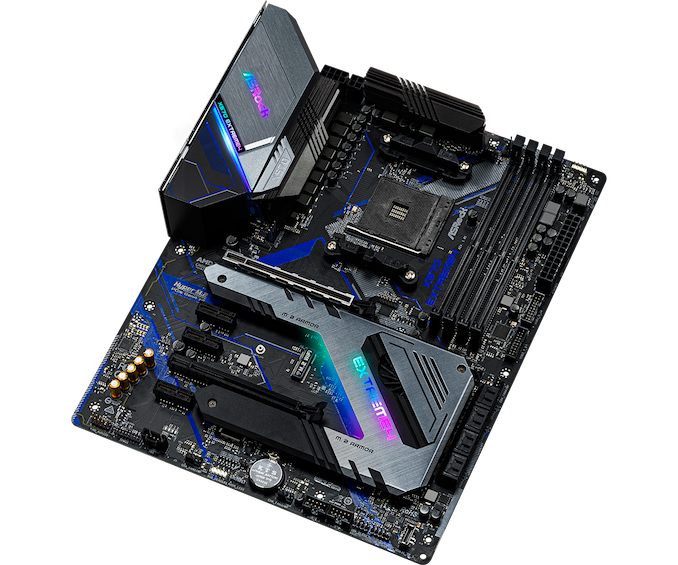The AMD X570 Motherboard Overview: Over 35+ Motherboards Analyzed
by Gavin Bonshor on July 9, 2019 8:00 AM ESTASRock X570 Extreme4
The ASRock X570 Extreme4 is another model which strafes itself away from the more gaming-oriented models from its product stack. Very similar in design and feature set to to the ASRock X570 Steel Legend, the X570 Extreme4 uses a black PCB with darker gunmetal grey colored heatsinks. It also has addressable RGB integrated into the rear panel cover and chipset heatsink, with support for ASRock's Polychrome Sync software.
Looking at the expansion slots available on the ASRock X570 Extreme4, there are two full-length PCIe 4.0 slots with support for x16, and x16/x4 which means up to two way AMD CrossFire is supported; the top full-length slot includes a coating of ASRock's Steel armor for better durability. In addition to this are three PCIe 4.0 x1 slots, and located underneath each of the full-length PCIe 4.0 slots are two PCIe 4.0 x4 M.2 slots, each with an individual heatsink which links into the actively cooled X570 chipset heatsink; also featured is eight SATA ports with RAID 0, 1 and 10 arrays all supported. Underneath the rear panel cover and the heatsinks is a 10-phase power delivery with an 8-pin and 4-pin 12 V ATX CPU power input to power the processor. At the top right-hand corner is four memory slots with support for up to DDR4-4666 and users can install up to a maximum of 64 GB of RAM.
On the rear panel is one USB 3.1 G2 Type-A, one USB 3.1 G2 Type-C and six USB 3.1 G1 Type-A ports, as well as an HDMI video output. While the ASRock X570 Extreme4 doesn't come with Wi-Fi enabled, there is an M.2 Key E 2230 slot for users to install their own wireless interface, and there are mounting holes located on the rear IO shield for this. Also located on the rear panel is a PS/2 combo port, a single Ethernet port controlled by an Intel I211-AT Gigabit NIC, and there are also five 3.5 mm color coded audio jacks and a S/DPIF optical output which are powered by a Realtek ALC1220 HD audio codec.
With a very similar feature set and overall aesthetic to the ASRock X570 Steel Legend model, the X570 Extreme4 features a more modest design with less of a focus on gaming, and more on performance whilst keeping a good quality core feature set. The ASRock X570 Extreme4 has an MSRP of $240, but users in the US can purchase a Wi-Fi 6 enabled version for the slightly higher cost of $250.












225 Comments
View All Comments
Supercell99 - Tuesday, July 9, 2019 - link
I also expected benchmarks and a naked woman serving me a beer.haukionkannel - Wednesday, July 10, 2019 - link
You did not get that? That is really strange... I was sure that that was the basic service in here!;)
Gastec - Wednesday, July 10, 2019 - link
I had a dream last night about a woman, she was serving me...benchmarks :)Duncan Macdonald - Tuesday, July 9, 2019 - link
Why is the DDR4 memory speed being shown as a feature of the chipset? The memory is directly driven by the CPU not the chipset and as such the memory speed is independent of the chipset.Dug - Tuesday, July 9, 2019 - link
The motherboard still has work to do and is what supports the faster speed memory. Just because the cpu allows it, doesn't mean it will work without the correct chipset.thomasg - Tuesday, July 9, 2019 - link
The chipset has nothing to do with it, it has no relation to RAM clock and is exclusively driven by the PCIe clock, which is unrelated.The mainboard itself has the traces and therefore the manufacturer is expected to provide appropriate timing sequences to load into the CPU, which again, is not done on the chipset.
There's no reason a mainboard manufacturer couldn't support faster RAM on any older, compatible board (provided they do a firmware update and the board is designed well enough), a chipset upgrade is not required.
Death666Angel - Wednesday, July 10, 2019 - link
"the board is designed well enough" There is the catch. It might be that Ryzen being the first of its kind meant that many 3xx boards were designed poorly.First test I've seen is TPUs R9 3900x on a ASUS Prime B350 Plus which they claim ran at 3200CL14, but only after setting it to 2666MHz first and letting it train the memory. But it's an encouraging result.
Dug - Tuesday, July 9, 2019 - link
I'm interested in seeing what coolers will fit on the mITX boards. Specifically ASRock X570 Phantom Gaming-ITX TB3.It looks like some of these boards might be limited due to high heatsinks and fans on the motherboards.
Mikewind Dale - Tuesday, July 9, 2019 - link
Could we please have a comparison table? 35 pages is too many read. It would be useful to have a comparison table so that I can narrow down the several motherboards I am interested in, and then compare their prices.halcyon - Tuesday, July 9, 2019 - link
A summary table of features would indeed be very helpful. Way too many boards and pages...